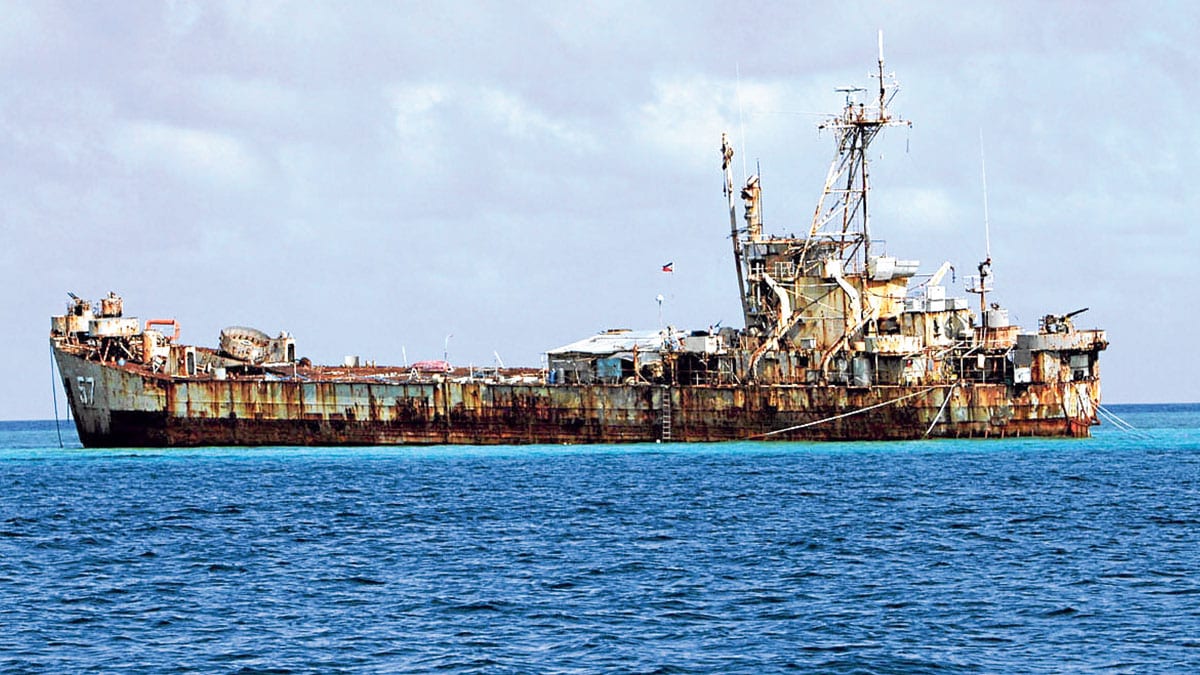Wescom chief: Ayungin troops in high spirits

MARITIME OUTPOST With inspired Filipino ingenuity, decrepit World War II-era BRP Sierra Madre was grounded near Ayungin (Second Thomas) Shoal in 1999 as a military outpost in the West Philippine Sea serving to deter China’s incursions. —INQUIRER PHOTO
SAN VICENTE, PALAWAN—Philippine Navy and Marine troops aboard BRP Sierra Madre remained in high spirits and unperturbed by the incident that happened near Panatag (Scarborough) Shoal on Aug. 11, when China Coast Guard (CCG) and People’s Liberation Army-Navy vessels collided with each other while harassing and trying to block Philippine Coast Guard Vessel BRP Suluan.
Vice Adm. Alfonso Torres Jr., chief of the Armed Forces of the Philippines Western Command (Wescom), said he recently talked with the troops aboard the Philippine Navy vessel that was intentionally grounded at Ayungin (Second Thomas) Shoal to serve as the Philippines’ military outpost in the area.
Torres said personnel aboard the BRP Sierra Madre told him they were doing their “normal days’ work” on the ship.
The number of troops aboard the Sierra Madre remained undisclosed and no details were made available as to how they were assigned to guard the country’s last frontier in the West Philippine Sea.
“I talked to them and they are in high spirits despite what happened in Bajo de Masinloc,” Torres said at the sidelines of the Combined and Joint Forcible Entry Operation (CJFEO) exercise on Sunday along the shores of Long Beach in this northwestern Palawan town.
‘With excellence’
The CJFEO activity was conducted as one of the highlights of ongoing Exercise Alon (Amphibious and Land Operation) 2025 between the Armed Forces of the Philippines and Australian Defence Force (ADF).
“They are practically doing their routine. They do what we instructed them to do. [I told them] Do your job, do it well, and do it with excellence so that they won’t be affected by what is happening,” he said.
The highest ranking military official in Palawan likewise stressed that the troops under Wescom have always been on alert for any eventuality and need not have to be on “extra alert.”
AFP Chief of Staff Gen. Romeo Brawner Jr., who also attended the CJFEO exercise, said that after the CCG and maritime militia vessels were spotted in the vicinity of Ayungin Shoal, the situation had since improved after Philippine troops managed to “push… the Chinese intrusions into the shoal itself,” located some 194 kilometers (105 nautical miles) west of Palawan.
“So successful tayo to push (away) the Chinese,” he said.
He also noted that the fish nets placed by the Chinese along Ayugin Shoal have been cut to clear the area for the next resupply mission to the Sierra Madre.
“They laid down nets so the order of our Western commander was to cut the fishing nets so that mobility would still be allowed within the shoal itself. This is in preparation of course for our resupply mission that we are going to do one of these days,” Brawner said in a separate interview.
‘Impressive and successful’
According to the AFP chief, future resupply missions will remain the same, based on what was agreed upon by the Department of Foreign Affairs (DFA) and their Chinese counterparts.
“We believe that the agreement that was set by the DFA and the Chinese counterpart still stands. That’s why we are optimistic that when the time comes for us to conduct resupply, they will respect and allow us to come,” Brawner said.
“But then, again, I always tell our troops that it is our right to do the resupply mission because we have to support our troops in BRP Sierra Madre,” he added.
Defense Secretary Gilberto Teodoro Jr., who also witnessed the drills, lauded the efforts of the AFP in what he described as an “impressive and successful” conduct of the CJFEO.
Teodoro said coordination between the Philippine and Australian forces went smoothly. INQ
For comprehensive coverage, in-depth analysis, visit our special page for West Philippine Sea updates. Stay informed with articles, videos, and expert opinions.


















